The Vehicle To Vehicle Communication Market is estimated to be valued at USD 36.4 billion in 2025 and is projected to reach USD 169.3 billion by 2035, registering a compound annual growth rate (CAGR) of 16.6% over the forecast period.
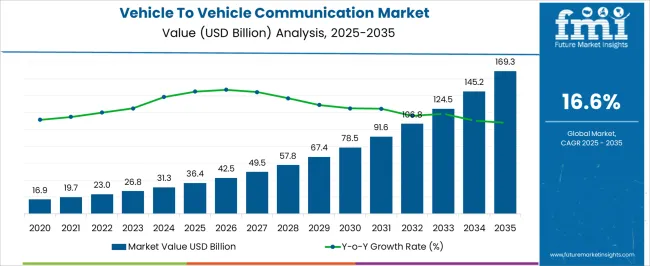
| Metric | Value |
|---|---|
| Vehicle To Vehicle Communication Market Estimated Value in (2025 E) | USD 36.4 billion |
| Vehicle To Vehicle Communication Market Forecast Value in (2035 F) | USD 169.3 billion |
| Forecast CAGR (2025 to 2035) | 16.6% |
The vehicle to vehicle communication market is witnessing strong growth as automakers and technology providers accelerate efforts to improve road safety, traffic efficiency, and autonomous driving readiness. Increasing government regulations that mandate vehicle communication technologies in several regions are driving adoption across passenger and commercial vehicles. Integration of advanced wireless technologies such as cellular V2X and dedicated short-range communication is enabling real-time exchange of data between vehicles, enhancing situational awareness and collision avoidance.
The growing deployment of intelligent transport systems and the rising demand for connected mobility solutions are further supporting market expansion. Big data and artificial intelligence are being increasingly integrated into these systems to improve predictive analytics, route optimization, and decision-making in autonomous driving.
Investments in smart city projects and expansion of 5G infrastructure are expected to create a favorable environment for widespread deployment As the automotive industry transitions toward connected and autonomous mobility, vehicle to vehicle communication is positioned as a core technology that will shape the future of transportation ecosystems globally.
The vehicle to vehicle communication market is segmented by technology, types of devices, and geographic regions. By technology, vehicle to vehicle communication market is divided into Big Data Analytics, Smart Sensors, Cloud Computing, and Others. In terms of types of devices, vehicle to vehicle communication market is classified into OEM Devices, Aftermarket Devices, and Infrastructure-based Devices. Regionally, the vehicle to vehicle communication industry is classified into North America, Latin America, Western Europe, Eastern Europe, Balkan & Baltic Countries, Russia & Belarus, Central Asia, East Asia, South Asia & Pacific, and the Middle East & Africa.
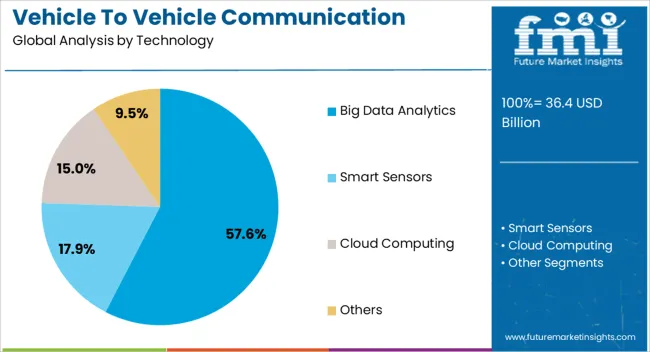
The big data analytics segment is projected to hold 57.6% of the vehicle to vehicle communication market revenue share in 2025, making it the leading technology segment. This dominance is being driven by the ability of big data platforms to process and analyze vast volumes of information generated by vehicles in real time. Enhanced decision-making, predictive maintenance, and optimized traffic management are enabled through advanced analytics capabilities.
The segment’s growth is supported by the increasing adoption of machine learning algorithms that improve accuracy in predicting driver behavior and potential hazards. Automakers and technology providers are leveraging big data analytics to enhance the reliability and scalability of vehicle communication systems, ensuring seamless integration with autonomous driving frameworks.
Furthermore, the growing emphasis on safety regulations and the need to reduce road accidents are encouraging investments in analytics-driven solutions As connected vehicle ecosystems expand, the critical role of big data analytics in enabling efficient, secure, and intelligent communication will reinforce its position as the leading technology segment.
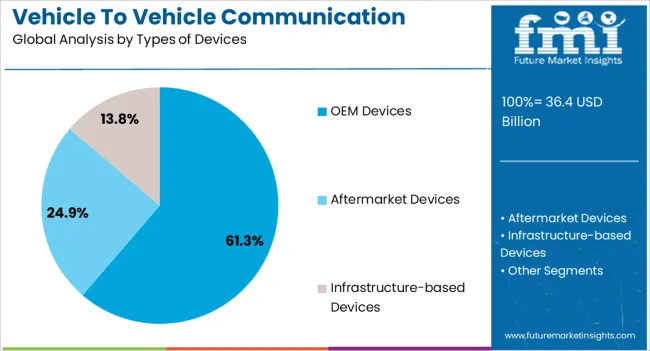
The OEM devices segment is expected to account for 61.3% of the vehicle to vehicle communication market revenue share in 2025, establishing itself as the dominant device type. This leadership is being reinforced by the integration of communication technologies directly into vehicles during manufacturing, ensuring compliance with regulatory standards and reducing aftermarket installation costs.
OEM-installed devices provide higher reliability, superior compatibility, and better security compared to retrofitted alternatives, making them the preferred choice for both automakers and consumers. The segment is also benefiting from the growing production of connected and autonomous vehicles, where communication systems are a fundamental requirement for safe and efficient operation.
Automakers are increasingly collaborating with technology providers to embed advanced communication modules and software into vehicles at the design stage, further supporting growth As consumer demand for factory-fitted connectivity solutions rises and regulatory frameworks tighten, OEM devices are anticipated to remain the leading segment, driving standardization and scalability across the global market.
Connected cars will improve safety and control congestion in cities, on the roads, cars would communicate and send alerts if a crash seem imminent, these features would attract the customers increasing their safety and ease to drive encouraging the vehicle to vehicle communication market.
Advancement in wireless communication, sharing of information, and growing roadside communication infrastructure are driving the vehicle to vehicle communication market and are also acting as building step for development of autonomous vehicles market. Vehicle to vehicle communication has become as active research area due to its potential to improve vehicle and road safety, traffic efficiency, convenience and comfort for passengers as well as drivers, these advancements impact positively to the V2V communication market.
Vehicle to vehicle communication market has a few restraints which include the implementation of V2V communication requires the automotive manufacturers to agree upon standards, funding, and data privacy concerns. V2V communication also requires lots of data which in turn requires scalable and more storage capable cloud platform.
To perform these communication a strong network is mandatory with advanced standards, sophisticated processing, analytical capabilities and technicalities. Standardization of protocol, security issues and countermeasures are a few more points which may drive V2V communication market negatively.
Vehicle to vehicle (V2V) communication market can be segmented based on technology and types of devices. On the basis of technology, vehicle to vehicle communication market can be segmented into big data analytics, smart sensors, cloud computing and others. Vehicles with access to cloud storage would enable them to access the library of maps, self-guided tours, and shortcuts.
Big data analytics and data science would help the companies to understand the customers by identifying the opportunities, and anticipating in relevant developments. Sensors would help in sensing the traffic enhancing the riding quality and experience of the passenger as well as driver in the vehicle. Automotive sensors are used to augment accuracy and V2V technology could act as an additional sensor that could augment the data available.
On the basis of types of devices V2V communication market can be segmented into OEM devices, aftermarket devices, and infrastructure-based devices. OEM device is build or integrated into the vehicle during vehicle production. Aftermarket devices are the device which may not be fully integrated to the vehicle but they solve the purpose and for convenience are added after the original assembly of the vehicle. Infrastructure based devices include the exchange of secure information and operational data between vehicles.
A lot of investment is done in experimenting and trying to develop the best vehicle to vehicle communication systems in the USA, Japan, and the European regions. North America, majorly the USA. dominates the global demand in vehicle to vehicle communication market.
European market is likely to witness highest growth. With the rise in population, people accepting the technological advancements and increasing number of vehicles in Asia Pacific and Middle East and Africa regions, the potential for vehicle to vehicle communication market is maximum in these areas as more and more automobile companies are focusing these regions. Latin America would witness a steady growth in the forecast period.
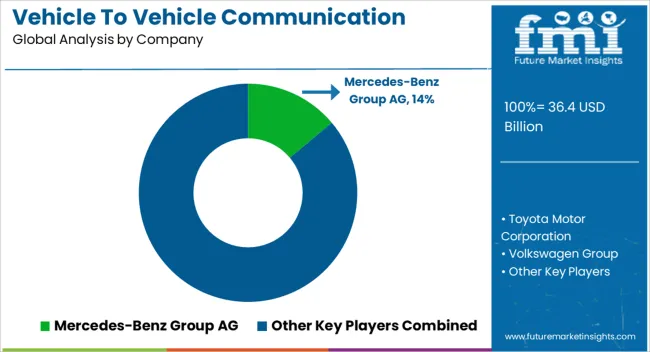
BMW, Audi, Daimler, Volvo, and Ford- Applink, are included among the automobile manufacturers who are focusing into vehicle to vehicle communication market. Among the solution providers Etrans Systems, Qualcomm Technologies Inc., Cisco Systems Inc., Delphi Automotive PLC, Autotalks Ltd., Denso, Arada Systems, Kapsch Group and Savari Inc., are included in the vehicle to vehicle communication market.
The report is a compilation of first-hand information, qualitative and quantitative assessment by industry analysts, inputs from industry experts and industry participants across the value chain. The report provides in-depth analysis of parent market trends, macro-economic indicators and governing factors along with market attractiveness as per segments. The report also maps the qualitative impact of various market factors on market segments and geographies.
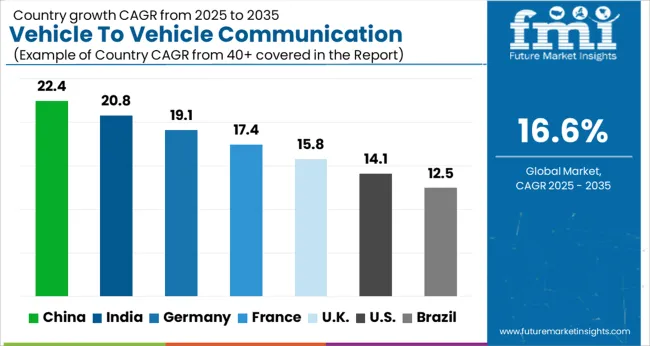
| Country | CAGR |
|---|---|
| China | 22.4% |
| India | 20.8% |
| Germany | 19.1% |
| France | 17.4% |
| UK | 15.8% |
| USA | 14.1% |
| Brazil | 12.5% |
The Vehicle To Vehicle Communication Market is expected to register a CAGR of 16.6% during the forecast period, exhibiting varied country level momentum. China leads with the highest CAGR of 22.4%, followed by India at 20.8%. Developed markets such as Germany, France, and the UK continue to expand steadily, while the USA is likely to grow at consistent rates. Brazil posts the lowest CAGR at 12.5%, yet still underscores a broadly positive trajectory for the global Vehicle To Vehicle Communication Market. In 2024, Germany held a dominant revenue in the Western Europe market and is expected to grow with a CAGR of 19.1%. The USA Vehicle To Vehicle Communication Market is estimated to be valued at USD 13.6 billion in 2025 and is anticipated to reach a valuation of USD 51.0 billion by 2035. Sales are projected to rise at a CAGR of 14.1% over the forecast period between 2025 and 2035. While Japan and South Korea markets are estimated to be valued at USD 2.0 billion and USD 1.1 billion respectively in 2025.
| Item | Value |
|---|---|
| Quantitative Units | USD 36.4 Billion |
| Technology | Big Data Analytics, Smart Sensors, Cloud Computing, and Others |
| Types of Devices | OEM Devices, Aftermarket Devices, and Infrastructure-based Devices |
| Regions Covered | North America, Europe, Asia-Pacific, Latin America, Middle East & Africa |
| Country Covered | United States, Canada, Germany, France, United Kingdom, China, Japan, India, Brazil, South Africa |
| Key Companies Profiled | Mercedes-Benz Group AG, Toyota Motor Corporation, Volkswagen Group, Harman International Industries, Mobileye Global Inc., Ford Motor Company, Bayerische Motoren Werke AG (BMW), Audi AG, Qualcomm Inc., Cisco Systems Inc., Autotalks Ltd., and DENSO Corporation |
The global vehicle to vehicle communication market is estimated to be valued at USD 36.4 billion in 2025.
The market size for the vehicle to vehicle communication market is projected to reach USD 169.3 billion by 2035.
The vehicle to vehicle communication market is expected to grow at a 16.6% CAGR between 2025 and 2035.
The key product types in vehicle to vehicle communication market are big data analytics, smart sensors, cloud computing and others.
In terms of types of devices, oem devices segment to command 61.3% share in the vehicle to vehicle communication market in 2025.






Our Research Products

The "Full Research Suite" delivers actionable market intel, deep dives on markets or technologies, so clients act faster, cut risk, and unlock growth.

The Leaderboard benchmarks and ranks top vendors, classifying them as Established Leaders, Leading Challengers, or Disruptors & Challengers.

Locates where complements amplify value and substitutes erode it, forecasting net impact by horizon

We deliver granular, decision-grade intel: market sizing, 5-year forecasts, pricing, adoption, usage, revenue, and operational KPIs—plus competitor tracking, regulation, and value chains—across 60 countries broadly.

Spot the shifts before they hit your P&L. We track inflection points, adoption curves, pricing moves, and ecosystem plays to show where demand is heading, why it is changing, and what to do next across high-growth markets and disruptive tech

Real-time reads of user behavior. We track shifting priorities, perceptions of today’s and next-gen services, and provider experience, then pace how fast tech moves from trial to adoption, blending buyer, consumer, and channel inputs with social signals (#WhySwitch, #UX).

Partner with our analyst team to build a custom report designed around your business priorities. From analysing market trends to assessing competitors or crafting bespoke datasets, we tailor insights to your needs.
Supplier Intelligence
Discovery & Profiling
Capacity & Footprint
Performance & Risk
Compliance & Governance
Commercial Readiness
Who Supplies Whom
Scorecards & Shortlists
Playbooks & Docs
Category Intelligence
Definition & Scope
Demand & Use Cases
Cost Drivers
Market Structure
Supply Chain Map
Trade & Policy
Operating Norms
Deliverables
Buyer Intelligence
Account Basics
Spend & Scope
Procurement Model
Vendor Requirements
Terms & Policies
Entry Strategy
Pain Points & Triggers
Outputs
Pricing Analysis
Benchmarks
Trends
Should-Cost
Indexation
Landed Cost
Commercial Terms
Deliverables
Brand Analysis
Positioning & Value Prop
Share & Presence
Customer Evidence
Go-to-Market
Digital & Reputation
Compliance & Trust
KPIs & Gaps
Outputs
Full Research Suite comprises of:
Market outlook & trends analysis
Interviews & case studies
Strategic recommendations
Vendor profiles & capabilities analysis
5-year forecasts
8 regions and 60+ country-level data splits
Market segment data splits
12 months of continuous data updates
DELIVERED AS:
PDF EXCEL ONLINE
Internet of Things Vehicle-to-Vehicle Communication Market
Vehicle-Mounted Payment Terminal Market Size and Share Forecast Outlook 2025 to 2035
Vehicle Scanner Market Size and Share Forecast Outlook 2025 to 2035
Vehicle Transfer Case Market Size and Share Forecast Outlook 2025 to 2035
Vehicle Barrier System Market Size and Share Forecast Outlook 2025 to 2035
Vehicle Acoustic DSP Chips Market Size and Share Forecast Outlook 2025 to 2035
Vehicle Cargo Box Market Size and Share Forecast Outlook 2025 to 2035
Vehicle Jump Starter Market Size and Share Forecast Outlook 2025 to 2035
Vehicle Moving Services Market Size and Share Forecast Outlook 2025 to 2035
Vehicle Security Sensor Market Size and Share Forecast Outlook 2025 to 2035
Vehicle Roadside Assistance Market Size and Share Forecast Outlook 2025 to 2035
Vehicle as a Service Market Size and Share Forecast Outlook 2025 to 2035
Vehicle Integrated Solar Panels Market Size and Share Forecast Outlook 2025 to 2035
Vehicle Networking Market Size and Share Forecast Outlook 2025 to 2035
Vehicle Armor Market Size and Share Forecast Outlook 2025 to 2035
Vehicle Conversion Market Size and Share Forecast Outlook 2025 to 2035
Vehicle Tracking System Market Size and Share Forecast Outlook 2025 to 2035
Vehicle Radar Test System Market Size and Share Forecast Outlook 2025 to 2035
Vehicle Electrification Market Growth - Trends & Forecast 2025 to 2035
Vehicle Control Unit (VCU) Market Growth & Demand 2025 to 2035

Thank you!
You will receive an email from our Business Development Manager. Please be sure to check your SPAM/JUNK folder too.
Chat With
MaRIA